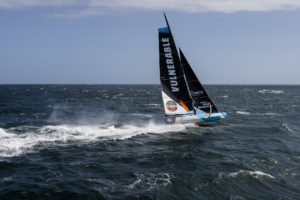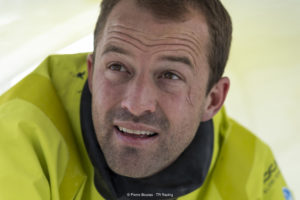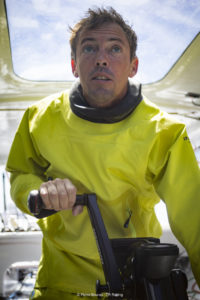TR Racing – Synergy
 The key concept underpinning the creation and philosophy of Thomas Ruyant Racing is the notion of working together.
The key concept underpinning the creation and philosophy of Thomas Ruyant Racing is the notion of working together.
It’s the idea that the interaction between two elements – in this case, two boats and two skippers – can give rise to a whole that is greater than the sum of its parts.
That’s why the buzzword around TR Racing at its base in Lorient on the French Brittany coast is “synergy.”
In a set-up that is unique in the IMOCA Class, two of the most talented skippers in solo ocean racing, the French veteran Thomas Ruyant and the British newcomer Sam Goodchild, are combining their talents sailing two boats from the same racing team.
While Ruyant campaigns his new Antoine Koch/Finot Conq-designed foiler (formerly known as For People), Goodchild is running Ruyant’s old IMOCA, the 2019-vintage Guillaume Verdier-designed rocketship formerly named LinkedOut and For The Planet.
They are supported by a 30-strong team of professionals and specialists – or “ultra-specialists” as Ruyant calls them – and while the team prepares as one, Ruyant and Goodchild race hard against each other on the ocean.
Indeed this autumn they will both start in the Vendée Globe solo round-the-world race with podium credentials; Ruyant, 42, will be looking to improve on his sixth place last time, while Goodchild, 34, will be making his debut.
Thomas Gavériaux, the Chief Executive Officer of TR Racing, says the choice to switch into a team in January 2023 was based on a collective conviction of just how powerful an arrangement a two-boat set-up could be. And, he argues, the early results have more than justified that belief.
“The first place it is paying off is in the results,” said Gavériaux. “The first season with TR Racing running two boats produced seven podiums out of 15 possibles. It was two victories for Thomas, five podiums for Sam and not forgetting the IMOCA Globe Series Championship for Sam, which also reflected his participation in The Ocean Race.”
From a management perspective, Gavériaux says the creation of the team broke new ground and imagined a new way of working in a fleet that has only ever seen skippers and their shore crews prepare largely on their own. “IMOCA is a culture where teams tend to be built around one individual – that’s the history of the Class,” he explained. “Then suddenly you are asking people, who have devoted most of their career to working for a one-man-band, to realise that the world is wiser when it’s wider.”
Team-building and sharing a common goal were important early objectives at TR Racing, which is backed by Advens. “We were relying a lot on the ability of the different members of the team to have confidence in each other to the point where they were happy to share their different experiences. They all come from different backgrounds and with different levels of expertise in various fields,” added Gavériaux. “The result is that we now have a pretty good collection of highly-skilled individuals that have engaged in this process with all the reasonable questions and doubts to start off with, but who have very quickly realised that this actually works.”
 While there is a five-strong dedicated shore team for each boat, the rest of TR Racing’s staff is spread across both sides of the boatshed and includes design office specialists, performance analysts, technical and composite specialists, plus staff employed in administration, accounting and management functions.
While there is a five-strong dedicated shore team for each boat, the rest of TR Racing’s staff is spread across both sides of the boatshed and includes design office specialists, performance analysts, technical and composite specialists, plus staff employed in administration, accounting and management functions.
Setting up a team like this depends critically on key individuals working together and buying into the philosophy. In Ruyant and Goodchild, Gavériaux has found that chemistry as the team looks to develop and optimise its newest boat, while maintaining Goodchild’s IMOCA as an immaculately-prepared reference. “When they started talking about the team and what it could achieve, both Sam and Thomas were 300% aligned and that’s key to making sure the rest of the group has followed on,” said Gavériaux.
Perhaps the biggest single benefit of a two-boat team is the opportunity it creates for comparative testing on the water and TR Racing is imbued with the principle that, almost invariably, if one boat goes out sailing so does the other. The team uses two-boat testing to evaluate new components, to evaluate new set-ups on board and to compare performance in a host of other ways. Gavériaux says this arrangement is so effective and time-efficient, it means that “every hour we spend on the water is worth three.”
Ruyant says the two-boat element has meant that he has been able to develop and optimise his new IMOCA far quicker than he would have done had he been working on his own. But he makes the point that it is not just about comparing numbers and data.
“We set the framework and there is a lot of openness and sharing,” says the skipper who won both last year’s Bermudes 1000 Race and the Transat Jacques Vabre (TJV). “So it’s not just the team sharing information and ideas with Sam, there’s obviously also a lot of input from him too. He’s sailed on a lot of different boats, particularly multihulls, and he’s had experience in The Ocean Race. So we are feeding off each other and the technical teams too, so that’s a big plus.”
Goodchild describes the two-boat element and working together as a “massive” difference. “In the IMOCA Class now-a-days, going sailing is quite rare, so being able to line-up against each other, and validate performance choices fairly quickly, is a lot easier with two boats on the water,” he said. “If we want to test something and go number-crunching, we will see how a component works on one boat and then see which is faster – you draw conclusions a lot quicker.”
Both Ruyant and Goodchild say that one big team of specialists working on two boats means there are usually more people in the room than would be the case in a single-boat set-up, when it comes to solving a problem and looking for solutions.
 “It’s more people around the same table with more ideas and you can bounce ideas off them, though you’ve still got to make a decision in the end,” said Goodchild. Ruyant agrees: “The more people there are, the more brain-storming there is and the more exchanges there are, so there’s a lot of internal problem-solving and creativity.”
“It’s more people around the same table with more ideas and you can bounce ideas off them, though you’ve still got to make a decision in the end,” said Goodchild. Ruyant agrees: “The more people there are, the more brain-storming there is and the more exchanges there are, so there’s a lot of internal problem-solving and creativity.”
Ruyant and Gavériaux say the TR Racing set-up is highly cost-efficient, especially when it comes to the shoreside functions. “There are genuine economies of scale,” explained Ruyant. “We use the same team base to prepare all year round, and we have shared logistics, shared communications, shared partners and shared tools too. All of which adds up to considerable savings. I think that two separate projects like ours would obviously cost a lot more.”
One risk of two boats and two skippers working under the same roof is that the competitive element between them can be compromised, something that is often seen in Formula 1 teams where one driver becomes the leader. In TR Racing that is not the case, as Ruyant makes clear.
“Of course there is this exchange of ideas and sharing, which is well-organised within the team, but it’s clear that once that startline is crossed, then for me, Sam will remain a competitor like any other,” he said.
For Goodchild, the benefits of sailing a fully-optimised and battle-hardened boat, which has won big races (including the Route du Rhum and the TJV), while working with a team and skipper in Ruyant who has enormous experience in the IMOCA Class, adds up to a dream package.
“From my side of things, this year it will be my first Vendée Globe and to be able to take that on from inside the structure of what was already a winning team is a massive benefit and massive advantage,” he said. “The structure of TR Racing definitely looks like a strength to me, and if you look at the results last year, you couldn’t really have hoped for much better.”
Ruyant has no doubt that TR Racing has been on the right track as it has developed from a successful one-boat team into a bigger outfit that, in Goodchild, has given an opportunity in IMOCA to one of the brightest young stars in the sport.
“This two-boat team is something new in ocean racing and in IMOCA racing,” he said. “But we like to do things differently and try out different ways of operating. These are methods we see in other sports, like motor racing, for example. If it’s well structured and well-organised, it works and that’s the case for us.”
